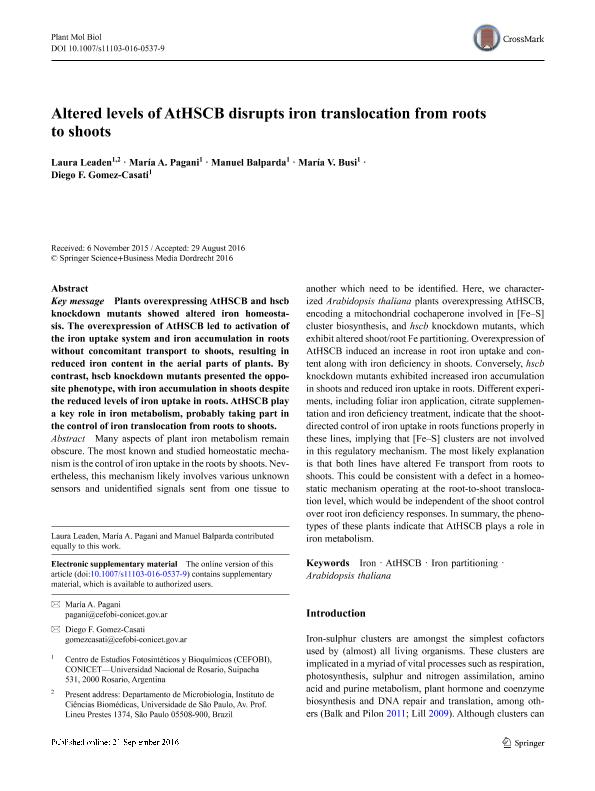Mostrar el registro sencillo del ítem
dc.contributor.author
Leaden, Laura

dc.contributor.author
Pagani, María Ayelén

dc.contributor.author
Balparda, Manuel

dc.contributor.author
Busi, María Victoria

dc.contributor.author
Gomez Casati, Diego Fabian

dc.date.available
2018-07-23T19:43:58Z
dc.date.issued
2016-11
dc.identifier.citation
Leaden, Laura; Pagani, María Ayelén; Balparda, Manuel; Busi, María Victoria; Gomez Casati, Diego Fabian; Altered levels of AtHSCB disrupts iron translocation from roots to shoots; Springer; Plant Molecular Biology; 92; 4-5; 11-2016; 613-628
dc.identifier.issn
0167-4412
dc.identifier.uri
http://hdl.handle.net/11336/52893
dc.description.abstract
Key message: Plants overexpressing AtHSCB and hscb knockdown mutants showed altered iron homeostasis. The overexpression of AtHSCB led to activation of the iron uptake system and iron accumulation in roots without concomitant transport to shoots, resulting in reduced iron content in the aerial parts of plants. By contrast, hscb knockdown mutants presented the opposite phenotype, with iron accumulation in shoots despite the reduced levels of iron uptake in roots. AtHSCB play a key role in iron metabolism, probably taking part in the control of iron translocation from roots to shoots. Abstract: Many aspects of plant iron metabolism remain obscure. The most known and studied homeostatic mechanism is the control of iron uptake in the roots by shoots. Nevertheless, this mechanism likely involves various unknown sensors and unidentified signals sent from one tissue to another which need to be identified. Here, we characterized Arabidopsis thaliana plants overexpressing AtHSCB, encoding a mitochondrial cochaperone involved in [Fe–S] cluster biosynthesis, and hscb knockdown mutants, which exhibit altered shoot/root Fe partitioning. Overexpression of AtHSCB induced an increase in root iron uptake and content along with iron deficiency in shoots. Conversely, hscb knockdown mutants exhibited increased iron accumulation in shoots and reduced iron uptake in roots. Different experiments, including foliar iron application, citrate supplementation and iron deficiency treatment, indicate that the shoot-directed control of iron uptake in roots functions properly in these lines, implying that [Fe–S] clusters are not involved in this regulatory mechanism. The most likely explanation is that both lines have altered Fe transport from roots to shoots. This could be consistent with a defect in a homeostatic mechanism operating at the root-to-shoot translocation level, which would be independent of the shoot control over root iron deficiency responses. In summary, the phenotypes of these plants indicate that AtHSCB plays a role in iron metabolism.
dc.format
application/pdf
dc.language.iso
eng
dc.publisher
Springer

dc.rights
info:eu-repo/semantics/openAccess
dc.rights.uri
https://creativecommons.org/licenses/by-nc-sa/2.5/ar/
dc.subject
Arabidopsis Thaliana
dc.subject
Athscb
dc.subject
Iron
dc.subject
Iron Partitioning
dc.subject.classification
Otras Ciencias Biológicas

dc.subject.classification
Ciencias Biológicas

dc.subject.classification
CIENCIAS NATURALES Y EXACTAS

dc.title
Altered levels of AtHSCB disrupts iron translocation from roots to shoots
dc.type
info:eu-repo/semantics/article
dc.type
info:ar-repo/semantics/artículo
dc.type
info:eu-repo/semantics/publishedVersion
dc.date.updated
2018-07-23T12:57:33Z
dc.journal.volume
92
dc.journal.number
4-5
dc.journal.pagination
613-628
dc.journal.pais
Alemania

dc.journal.ciudad
Berlin
dc.description.fil
Fil: Leaden, Laura. Consejo Nacional de Investigaciones Científicas y Técnicas. Centro Científico Tecnológico Conicet - Rosario. Centro de Estudios Fotosintéticos y Bioquímicos. Universidad Nacional de Rosario. Facultad de Ciencias Bioquímicas y Farmacéuticas. Centro de Estudios Fotosintéticos y Bioquímicos; Argentina. Universidade de Sao Paulo; Brasil
dc.description.fil
Fil: Pagani, María Ayelén. Consejo Nacional de Investigaciones Científicas y Técnicas. Centro Científico Tecnológico Conicet - Rosario. Centro de Estudios Fotosintéticos y Bioquímicos. Universidad Nacional de Rosario. Facultad de Ciencias Bioquímicas y Farmacéuticas. Centro de Estudios Fotosintéticos y Bioquímicos; Argentina
dc.description.fil
Fil: Balparda, Manuel. Consejo Nacional de Investigaciones Científicas y Técnicas. Centro Científico Tecnológico Conicet - Rosario. Centro de Estudios Fotosintéticos y Bioquímicos. Universidad Nacional de Rosario. Facultad de Ciencias Bioquímicas y Farmacéuticas. Centro de Estudios Fotosintéticos y Bioquímicos; Argentina
dc.description.fil
Fil: Busi, María Victoria. Consejo Nacional de Investigaciones Científicas y Técnicas. Centro Científico Tecnológico Conicet - Rosario. Centro de Estudios Fotosintéticos y Bioquímicos. Universidad Nacional de Rosario. Facultad de Ciencias Bioquímicas y Farmacéuticas. Centro de Estudios Fotosintéticos y Bioquímicos; Argentina
dc.description.fil
Fil: Gomez Casati, Diego Fabian. Consejo Nacional de Investigaciones Científicas y Técnicas. Centro Científico Tecnológico Conicet - Rosario. Centro de Estudios Fotosintéticos y Bioquímicos. Universidad Nacional de Rosario. Facultad de Ciencias Bioquímicas y Farmacéuticas. Centro de Estudios Fotosintéticos y Bioquímicos; Argentina
dc.journal.title
Plant Molecular Biology

dc.relation.alternativeid
info:eu-repo/semantics/altIdentifier/doi/https://dx.doi.org/10.1007/s11103-016-0537-9
dc.relation.alternativeid
info:eu-repo/semantics/altIdentifier/url/https://link.springer.com/article/10.1007%2Fs11103-016-0537-9
Archivos asociados
